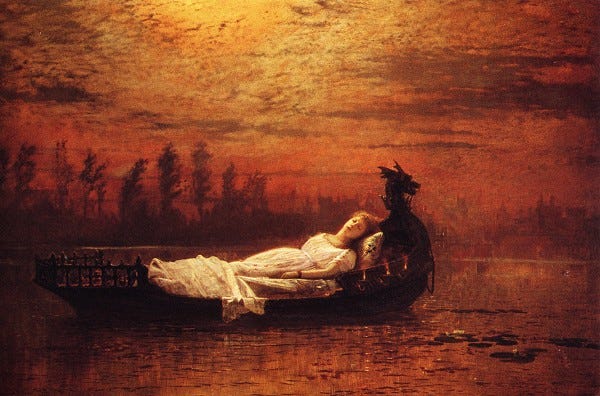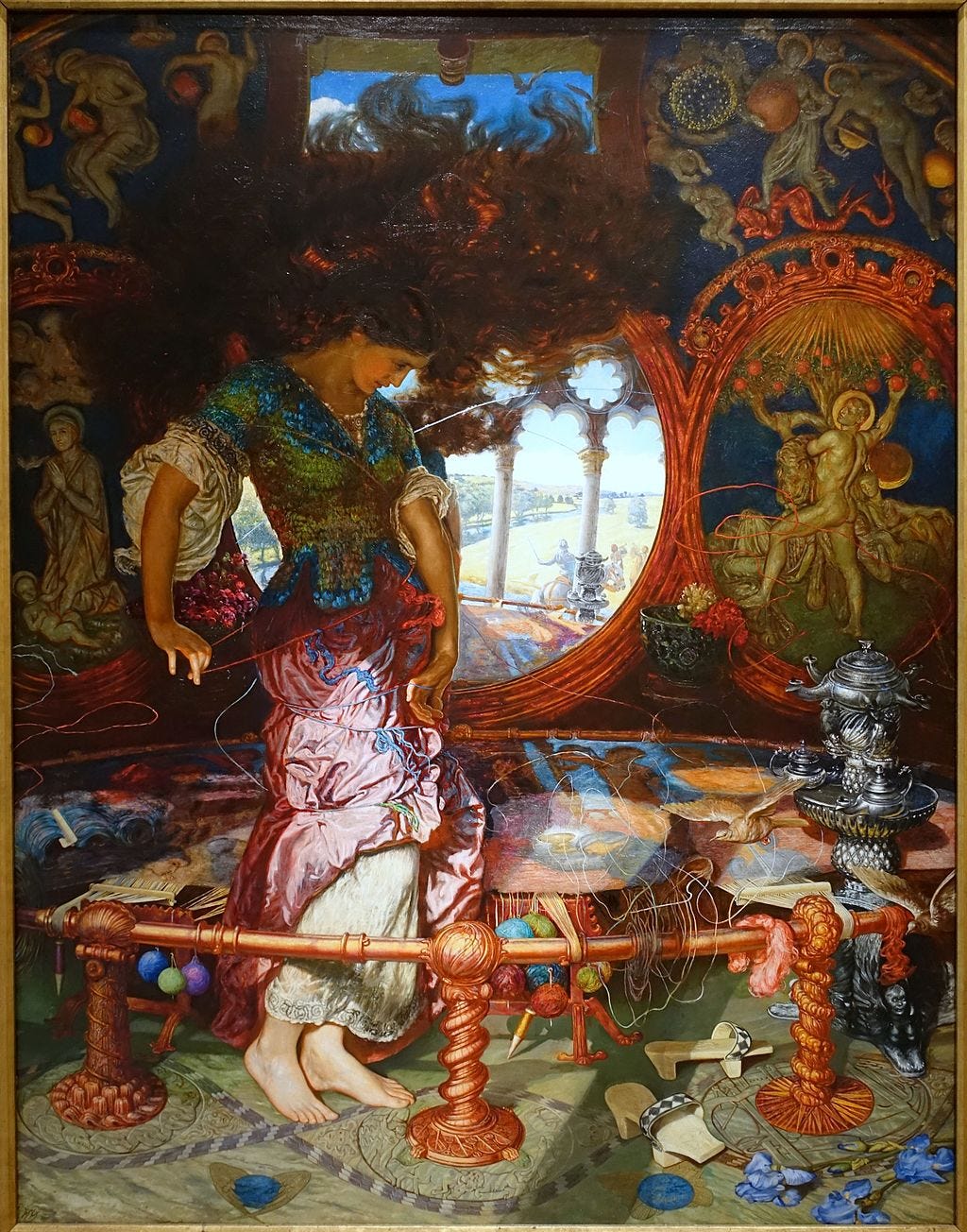Week 8 - The Lady of Shalott Meets Elgar's Sospiri
Delve into the mystical allure of Waterhouse's The Lady of Shalott, enriched by the enchanting harmonies of Elgar's Sospiri Op. 70
Good morning!
Welcome to the eighth issue of the Monday Morning Art Dispatch.
In this issue, we’ll explore two captivating masterpieces. First, we delve into John William Waterhouse's “The Lady of Shalott.” This haunting painting depicts the tragic journey of Elaine of Astolat, heroine from Arthurian legend, drawing viewers into her mystical and touching world.
To complement this visual journey, I’ve chosen Edward Elgar's "Sospiri, Op. 70," performed by the London Symphony Orchestra under the direction of Herbert von Karajan. This deeply emotional orchestral piece, with its lush harmonies and evocative melodies, perfectly mirrors the melancholic beauty and otherworldly atmosphere of Waterhouse's painting.
Join me in exploring these artistic treasures, highlighting the deep emotions and timeless beauty they evoke.
The Painting
The Lady of Shalott
William Waterhouse's "The Lady of Shalott" is often associated with the Pre-Raphaelite tradition, though his style diverges in significant ways from the core Pre-Raphaelite approach. It captures a poignant moment from Alfred Lord Tennyson's poem of the same name.
Painted in 1888, this masterpiece is renowned for its rich detail, emotional depth, and symbolic complexity. While Waterhouse drew inspiration from the themes and subjects favored by the Pre-Raphaelites, his technique and execution align more closely with the academic and classical traditions of the late 19th century. Waterhouse's interpretation of the Lady of Shalott stands out among other artistic renditions, making it a significant piece in the history of art.
The painting depicts the tragic figure of the Lady of Shalott as she floats down the river towards Camelot, her fate sealed by a curse. Waterhouse uses rich, vivid colors to draw the viewer into the scene. The Lady is shown in a small boat, surrounded by the lush, natural landscape of the riverbank. Her expression is one of sorrow and resignation, reflecting her awareness of the impending doom. The details in her flowing white dress and the tapestry she has woven, which drapes over the boat, emphasize her delicate beauty and the intricacies of her work.
Historically, Waterhouse's painting is part of a broader tradition of depicting Tennyson's poem. Other notable artists, such as John Atkinson Grimshaw and William Holman Hunt, have also created works inspired by "The Lady of Shalott." Grimshaw's version, painted in 1878, captures the dead Lady of Shalott floating down the river in her funeral barge. This painting, much like his earlier work "Elaine" from 1877, conveys the atmospheric stillness of the scene as the Lady floats through the night. In "The Lady of Shalott," Grimshaw portrays the dead Lady recumbent in an exotic barge set against a wooded background and moonlit sky, emphasizing the serene yet somber mood.
Hunt's version, on the other hand, focuses on the Lady in her tower, highlighting her isolation and the internal conflict she faces as she weaves her tapestry. These interpretations, while powerful, differ significantly from Waterhouse's approach.
Waterhouse's composition is carefully balanced. The Lady is placed centrally, making her the focal point. The background features dark, foreboding trees and a grey sky, enhancing the melancholic atmosphere. The water, painted with smooth, reflective strokes, mirrors the somber mood and adds a sense of depth to the scene. Unlike Grimshaw and Hunt, who focus more on the Lady's confinement and the aftermath of her curse, Waterhouse emphasizes the moment of transition—her decision to leave the safety of her tower and face her destiny.
The technique Waterhouse applied in this painting is notable for its use of light and shadow. The soft light illuminates the Lady's face and dress, creating a stark contrast with the darker elements around her. This use of chiaroscuro (the contrast between light and dark) not only highlights the Lady but also adds a dramatic effect, emphasizing the tension between her inner turmoil and the serene environment.
Symbolism plays a significant role in "The Lady of Shalott." The chain attached to the boat symbolizes the Lady's confinement and the curse that binds her. The candles, some extinguished and some still burning, represent the fragility of life and the passage of time. The mirror, a key element in Tennyson's poem, is not depicted directly but is implied through the reflective water, suggesting the Lady's view of the outside world before the curse took hold.
William Waterhouse revisited the theme of "The Lady of Shalott" twice more after his 1888 painting, each time exploring different aspects of the Lady's story. In 1894, he created a version that focuses on the moment the Lady leaves her loom and looks out of the window, thereby invoking the curse. This painting captures the instant of her defiance and the subsequent realization of her doomed fate, emphasizing her internal conflict and the dramatic consequences of her actions.
In 1915, Waterhouse painted his final version of "The Lady of Shalott." This work depicts an earlier point in the tale than those depicted in his previous works of 1888 and 1894. The Lady is still confined in her tower, weaving a tapestry, and viewing the world outside only through the reflection in a large mirror in the background. The composition is less dramatic and more introspective, illustrating the Lady's quiet resignation and acceptance of her fate
Waterhouse's painting invites viewers to explore themes of isolation, fate, and the conflict between art and life. The Lady of Shalott, trapped by her curse, represents the artist's struggle between the desire for creative expression and the constraints imposed by society. By capturing this moment of transition—her decision to leave the safety of her tower and face her destiny—Waterhouse evokes a powerful emotional response.
Today, the 1888 painting is housed in the Tate Britain gallery in London, where it continues to captivate and inspire visitors from around the world.
The Music
Edward Elgar composed "Sospiri, Op. 70" in the summer of 1914, a time marked by personal reflection and the looming shadow of World War I. The piece, originally intended as a violin and piano piece, evolved into a heartfelt adagio for strings, harp, and organ, capturing a deep sense of longing and melancholy.
When pairing it with William Waterhouse's "The Lady of Shalott," I find that "Sospiri" creates an ideal soundscape for the viewing experience. The music’s sentimental and ethereal quality mirrors the tragic beauty and emotional depth of Waterhouse's painting. Both the composition and the artwork evoke themes of surrendering to fate, and the haunting passage of time, that I think resonate with the viewing experience of Waterhouse’s painting profoundly.
Elgar's "Sospiri" is known for its emotional intensity and delicate orchestration. The piece begins with a sorrowful string melody, underscored by the gentle plucking of the harp and the solemn tones of the organ. This combination of instruments creates a rich, layered texture that evokes the Lady's sorrowful journey down the river. The change in the music with its moments of quiet reflection and surges of emotional intensity, perfectly complement the visual narrative of Waterhouse's painting.
The interpretation by the London Symphony Orchestra, conducted by Herbert von Karajan, adds a layer of emotional depth and historical significance to Elgar's composition. Karajan, renowned for his meticulous attention to detail and expressive conducting style, brings out the nuanced emotions and intricate textures of "Sospiri." His interpretation captures the delicate balance between sorrow and beauty inherent in Elgar's score, echoing the dramatic interplay of light and shadow in Waterhouse's painting. Karajan's sensitive phrasing and dynamic contrasts enhance the emotional journey, making the experience of listening to "Sospiri" while viewing "The Lady of Shalott" quite immersive.
When experiencing both works together, it feels as if the music is inviting us to share in the Lady's final journey. In this pairing, both the visual and auditory elements come together to create a moving experience, highlighting the timeless themes of love, loss, and the inexorable passage of time.
Bonus
In Tennyson's poem "The Lady of Shalott," the climactic moment arrives as the Lady, bound by a mysterious curse, finally defies her fate. Confined to weaving a magical web and observing the world only through a mirror, she glimpses the vibrant and alluring figure of Sir Lancelot. Overwhelmed by a desire to experience life beyond her isolated tower, she abandons her loom and gazes directly at Camelot. This decisive action shatters her enchanted mirror and unleashes the curse, marking a powerful and irreversible turning point in her tragic story. The following stanza captures this moment of defiance and its immediate, devastating consequences.
She left the web, she left the loom
She made three paces thro' the room
She saw the water-flower bloom,
She saw the helmet and the plume,
She look'd down to Camelot.Out flew the web and floated wide;
The mirror crack'd from side to side;
'The curse is come upon me,' cried
The Lady of Shalott.







I love the Pre-Raphaelites! Did you know that they also revered Raphael despite their name?
Your offerings are so rich but I can't keep up. Would you consider slowing down to once a month? I like to savor them but I find myself skipping episodes and that is sad after all you put into them!